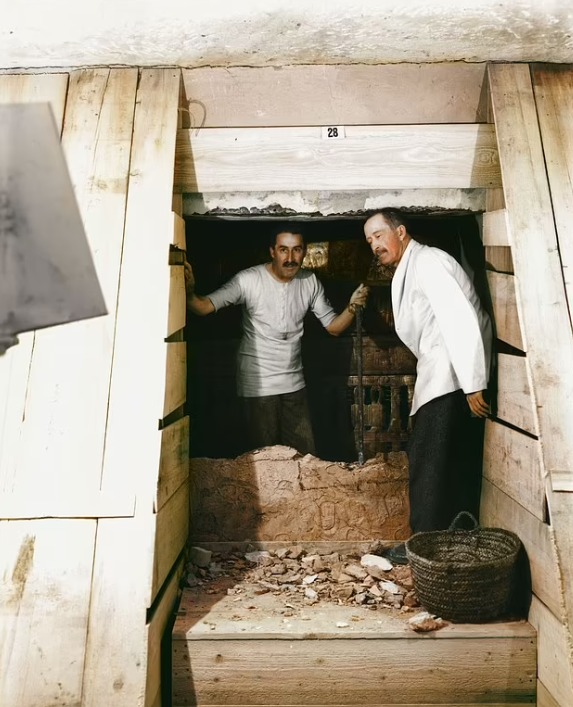Headline
PICTORIAL: British Egyptologists Uncover Ancient Pharaoh’s Tomb In Egypt

Over a century after the discovery of Tutankhamun’s tomb, British Egyptologists have made another groundbreaking find — the long-lost burial site of Pharaoh Thutmose II, a ruler of Egypt’s 18th Dynasty who lived nearly 3,500 years ago.
The tomb, identified as “C4,” was discovered approximately 2.4 km west of the Valley of the Kings in Luxor.
The Egyptian Ministry of Tourism and Antiquities confirmed the find, finally resolving the mystery surrounding Thutmose II’s resting place.
For generations, scholars believed his tomb was located near the Valley of the Kings. However, a team led by Professor Piers Litherland from the University of Cambridge uncovered it in an unexpected location — an area previously associated with the burials of royal women.

READ ALSO: Trump Proposes Relocating Gaza Residents To Egypt, Jordan
According to the BBC on Thursday, the entrance to the tomb was first identified in 2022, but extensive excavation was required before experts could confirm that it belonged to Thutmose II. Professor Litherland, who has spent over a decade exploring the Valley of the Kings, discovered a staircase carved into the rock at the base of a cliff, leading to a grand descending corridor.
Initially, the team suspected they had found the tomb of a royal wife.
However, the large doorway and staircase suggested something far more significant. The chamber was filled with sand and limestone debris from ancient floods, delaying access to the burial site. After painstaking excavation, they finally reached the burial chamber.
Inside, they found a ceiling painted blue with yellow stars — a design reserved exclusively for pharaohs. The walls were adorned with scenes from the Amduat, an ancient religious text intended only for kings.

READ ALSO: Trump Proposes Relocating Gaza Residents To Egypt, Jordan
Additionally, fragments of alabaster jars bore inscriptions confirming Thutmose II as the “deceased king,” alongside the name of his wife, Hatshepsut.
Unlike the famous tomb of Tutankhamun, Thutmose II’s chamber contained no treasures or mummified remains. Experts believe flooding forced ancient Egyptians to relocate the pharaoh’s body to the Deir el-Bahri cache, where it was discovered in the 19th century in poor condition — his remains were damaged, and his right arm had been severed.

However, recent studies have cast doubt on the identity of the mummy. The remains are estimated to belong to a man over 30 years old, yet Thutmose II is believed to have died before reaching 30.
Scholars suggest he may have succumbed to disease, as his embalmed body showed signs of an illness that the mummification process could not erase.
Thutmose II ruled either for 13 years (1493–1479 BCE) or as little as three years (1482–1479 BCE), according to various historical estimates. He was part of Egypt’s 18th Dynasty, a period often regarded as the pinnacle of Ancient Egyptian civilization. The dynasty, which lasted over 200 years (circa 1539–1292 BCE), produced legendary figures such as Hatshepsut, Amenhotep I, and Tutankhamun.

Headline
Benin Republic Presidency Breaks Silence On ‘Military Takeover’

Benin Republic military
Military personnel in Benin on Sunday said they had ousted President Patrice Talon, but the Presidency said he was safe and the army was regaining control.
Talon, 67, a former businessman known as the “cotton king of Cotonou,” is due to hand over power in April next year after 10 years in office marked by strong economic growth and rising jihadist violence.
West Africa has seen several coups in recent years, including in Niger, Burkina Faso, Mali, Guinea, and most recently Guinea-Bissau.
Early on Sunday, soldiers calling themselves the “Military Committee for Refoundation” (CMR) said on state television that they had met and decided that “Mr Patrice Talon is removed from office as president of the republic.”
READ ALSO:Guinea-Bissau Military Takeover Is ‘Ceremonial Coup’ – Jonathan
The signal was cut later in the morning.
Shortly after the announcement, a source close to Talon told AFP the president was safe.
“This is a small group of people who only control the television. The regular army is regaining control. The city (Cotonou) and the country are completely secure,” they said.
“It’s just a matter of time before everything returns to normal. The clean-up is progressing well.”
A military source confirmed the situation was “under control” and said the coup plotters had not taken Talon’s residence or the presidential offices.
READ ALSO:Coup: ECOWAS Suspends Guinea-Bissau
The French Embassy reported on X that “gunfire was reported at Camp Guezo” near the president’s official residence in the economic capital and urged French citizens to remain indoors.
Benin has a history of coups and attempted coups.
Talon, who came to power in 2016, is due to end his second term in 2026, the constitutional maximum.
The main opposition party has been excluded from the race to succeed him, leaving the ruling party to compete against a so-called “moderate” opposition.
Talon has been praised for driving economic development but is often accused of authoritarianism.
(AFP)
Headline
JUST IN: Soldiers Announce Military Takeover Of Govt In Benin Republic

A group of soldiers appeared on Benin’s state television on Sunday to announce the dissolution of the government in what is being described as an apparent coup, marking yet another power seizure in West Africa.
Identifying themselves as the Military Committee for Refoundation, the soldiers declared the removal of the president and all state institutions.
READ ALSO:Guinea-Bissau Military Takeover Is ‘Ceremonial Coup’ – Jonathan
President Patrice Talon, who has been in office since 2016, was scheduled to leave office next April after the presidential election. His party’s preferred candidate, former Finance Minister Romuald Wadagni, had been widely viewed as the frontrunner. Opposition candidate Renaud Agbodjo was disqualified by the electoral commission on the grounds that he did not have “sufficient sponsors.”
The takeover comes a month after Benin’s legislature extended the presidential term from five to seven years while retaining the two-term limit.
(AFP)
Headline
EU Fines Elon Musk’s X €120m For Violating Digital Content Rules

Elon Musk’s social media platform, X, has been hit with a €120 million ($140 million) fine by European Union tech regulators for violating multiple provisions of the EU’s Digital Services Act (DSA).
This marks the first significant penalty imposed under this landmark legislation.
On Friday, the European Commission announced the fine, citing various violations by X, including misleading platform features and a lack of transparency in research practices.
READ ALSO:Elon Musk Deletes Post Claiming Trump Was ‘In The Epstein Files’
Regulators pointed out that one of the violations involved the misleading design of the blue verification checkmark. This feature is now linked to subscription payments instead of identity validation, which the EU described as “deceptive and potentially harmful.”
The Commission also criticized X for not maintaining transparent advertising records and for restricting researchers’ access to publicly available data on the platform.
This ruling is likely to heighten diplomatic tensions between Brussels and Washington. U.S. officials from the Trump administration had previously condemned Europe’s regulatory approach toward major tech companies, claiming that EU policies unfairly target American firms and restrict free expression.
READ ALSO:Elon Musk Joins ‘Cancel Netflix’ Campaign
However, the European Commission defended its stance, stating that enforcement under the DSA is not influenced by nationality. They emphasized that the legislation is designed to promote online accountability, protect users, and ensure transparency in digital operations—standards that are increasingly becoming global benchmarks.
“The DSA does not discriminate by company origin,” the Commission argued, maintaining that the penalties reflect Europe’s commitment to protecting democratic values and responsible digital governance.
The fine marks a significant test case for the EU’s new regulatory regime and could set precedent for similar action against other platforms not in full compliance with the law.

 Entertainment5 days ago
Entertainment5 days ago2face, Natasha Fight Dirty On Instagram Live Amid Singer’s Alleged Arrest In UK

 News4 days ago
News4 days agoEdo Assembly Recalls 324 Employment Letters

 News5 days ago
News5 days agoBREAKING: Tinubu Nominates New Defence Minister

 News4 days ago
News4 days agoImansuangbon Donates To Benin IDPs, Charges Wealthy Nigerians To Advance Humanity

 News5 days ago
News5 days agoEdo Assembly Summons 2Baba’s Wife Before Ethics Committee

 Metro2 days ago
Metro2 days agoEdo: How Pastor Hypnotised My Daughter, Made Her Abandoned NNPCL- Mother

 Sports5 days ago
Sports5 days agoEPL: Mikel Obi Reveals Why Chelsea Failed To Beat Arsenal in 1-1 Draw

 Metro4 days ago
Metro4 days agoWhy We Killed Ogun FRSC Officer, Daughter — Suspect Manfriend, Herbalists

 Business4 days ago
Business4 days agoJUST IN: CBN Removes Cash Deposit Limits, Raises Weekly Withdrawal To N500,000

 Business5 days ago
Business5 days agoNaira Records Depreciation Against US Dollar Across Official, Black Markets
































